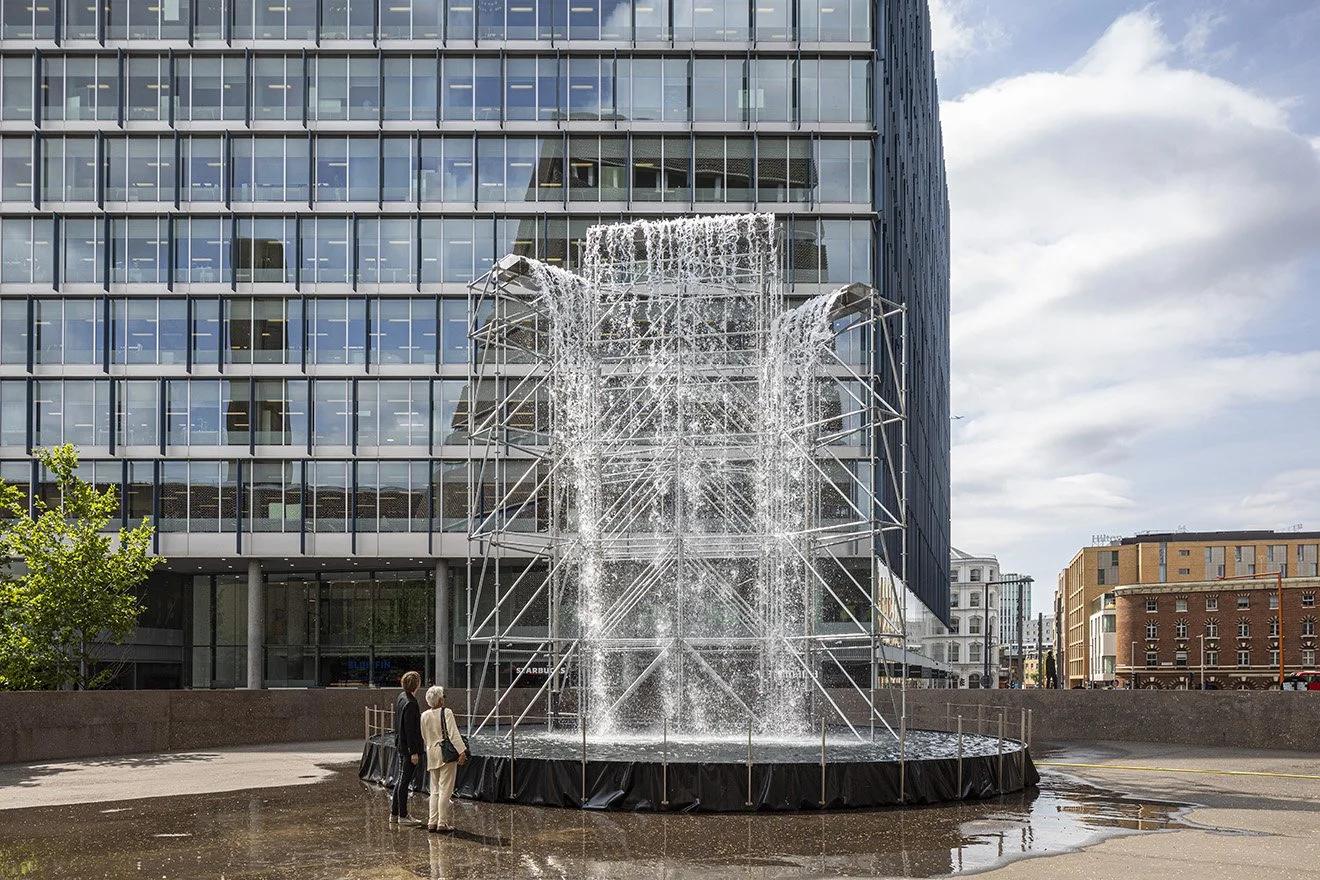Olafur Eliasson: In Real Life
The Tate Modern’s latest exhibition features over 40 art pieces created by Danish-Icelandic artist Olafur Eliasson from 1990 to the present. Born in 1967, Eliasson has produced many works, including installations, sculptures, photographs, and paintings, utilising materials such as moss, glacial meltwater, fog, light, and reflective metals. His artistic practice is deeply rooted in three key interests: a concern for nature shaped by his experiences in Iceland, exploration of geometry, and investigations into our perceptions and interactions with the world around us.
Olafur Eliasson Your uncertain shadow (colour), 2010 / Photography: María del Pilar García Ayensa / Studio Olafur Eliasson Thyssen-Bornemisza Art Contemporary Collection, Vienna © 2010 Olafur Eliasson
Experience is central to Eliasson’s art. He hopes that engaging with his works enhances your sensory awareness, allowing you to add personal meaning through your associations and memories. This interaction may also increase your awareness of those around you, fostering a momentary community. Eliasson believes this heightened awareness of oneself and others engenders a new sense of responsibility. He argues that art can profoundly influence our world beyond museum walls.
Olafur Eliasson Waterfall, 2019 / Photography: Anders Sune Berg Courtesy the artist; neugerriemschneider, Berlin; Tanya Bonakdar Gallery, New York / Los Angeles © 2019 Olafur Eliasson
Eliasson operates a studio in Berlin that employs technicians, architects, archivists, art historians, designers, filmmakers, cooks, and administrators. His exhibitions and commissions are held globally. Eliasson and his studio members collaborate with architects, policymakers, chefs, activists, musicians, and choreographers. Stemming from his fascination with light and the environment, he has initiated projects focused on sustainable energy and the climate crisis.
Olafur Eliasson in collaboration with Einar Thorsteinn - Model room - 2003 / Photo: Anders Sune Berg / Moderna Museet, Stockholm. Purchase 2015 funded by The Anna-Stina Malmborg and Gunnar / Höglund Foundation / © 2003 Olafur Eliasson
Model Room
This case features approximately 450 models, prototypes, and geometric studies in various sizes. Together, they document Olafur Eliasson’s collaborative work with his studio team and the Icelandic artist, mathematician, and architect Einar Thorsteinn (1942–2015).
From 1996 to 2014, Thorsteinn and Eliasson worked together on multiple projects, exploring the geometric shapes, symmetries, and ratios that inform many of Eliasson’s sculptures and pavilions. For instance, one of the modular shapes displayed here is a study for Your Spiral View 2002, which is part of this exhibition.
These models are crafted from diverse materials such as copper wire, cardboard, paper photocopies, Lego, wood, foam, and rubber balls. For many years, they acted as a reference ‘library’ for Studio Olafur Eliasson. Currently, the Model Room resides at Moderna Museet in Stockholm, while the studio, particularly its design and geometry teams, continues to develop models and prototypes for ongoing research.
(1) Olafur Eliasson Beauty 1993 / Photography: Anders Sune Berg Courtesy of the artist; neugerriemschneider, Berlin; Tanya Bonakdar Gallery. (2) Olafur Eliasson Wavemachines, 1995 Photography: Anders Sune Berg Kunstmuseum Basel © 1995 Olafur Eliasson (3) Olafur Eliasson Moss wall, 1994 / Photography: Anders Sune Berg Courtesy the artist; neugerriemschneider, Berlin; Tanya Bonakdar Gallery, New York / Los Angeles © 1994 Olafur Eliasson
Early Works
This room showcases many of Eliasson’s early pieces, highlighting the interests that still drive his artistic vision today.
The works Window Projection (1990), Wannabe (1991), and I Grew Up in Solitude and Silence (1991) were created while Eliasson was still attending art school. Each piece employs various types of light to transform the viewer's experience of space and architecture. True to Eliasson’s style at the time, the mechanisms used are straightforward and always visible.
Eliasson has consistently expressed a fascination with nature and the weather. From the beginning, he linked his experiences of the Icelandic landscape with sculpture-making. Some pieces, like Wavemachines (1995), emulate natural phenomena, while others, such as Regenfenster (Rain Window) (1999), simulate the effects of specific weather conditions. Moss Wall (1994), made from Scandinavian reindeer lichen, brings an unexpected outdoor element into the museum's controlled indoor environment, stimulating the senses with its texture and scent.
These themes of light, nature, and perception also inspired early installations like Beauty (1993) and No Nights in Summer, No Days in Winter (1994), which can be found in the two spaces beyond this room.
(1) Olafur Eliasson Your spiral view, 2002 / Photography: Anders Sune Berg Boros Collection, Berlin © 2002 Olafur Eliasson / (2) Olafur Eliasson Your planetary window, 2019 Photography: Anders Sune Berg Courtesy the artist; neugerriemschneider, Berlin; Tanya Bonakdar Gallery, New York / Los Angeles © 2019 Olafur Eliasson (3) Olafur Eliasson In real life, 2019 / Photography: Anders Sune Berg Courtesy of the artist; neugerriemschneider, Berlin; Tanya Bonakdar Gallery, New York / Los Angeles © 2019 Olafur Eliasson
Kaleidoscopes
Eliasson has been creating kaleidoscopes since the mid-1990s. In this room, two works are showcased: the earlier piece, Your spiral view 2002, and the more recent Your planetary window 2019.
For the artist, the kaleidoscope transcends mere visual play. Its multiple reflections shatter and rearrange your view, presenting various perspectives simultaneously and offering new insights into your position. This experience may lead you to relinquish the feeling of controlling space, welcoming a sense of uncertainty instead. Eliasson frequently employs the kaleidoscope to blend the interior and exterior of an exhibition, altering the perception of both by blurring the boundary between the gallery and the outside world.
Additionally, Eliasson has created a series of suspended spheres, including two outside the exhibition and a new piece titled In real life 2019 displayed here. Each sphere is designed according to a sophisticated yet regular geometric principle. The artist is especially drawn to spirals because they evoke a sense of energy, both within the object and externally, as light and shadows dance upon the surrounding walls.
Olafur Eliasson and Minik Rosing Ice Watch, 2014 Supported by Bloomberg Photography: Charlie Forgham Bailey © 2018 Olafur Eliasson and Minik Rosing (2) Olafur Eliasson The presence of absence pavilion, 2019 / Photography: Anders Sune Berg Courtesy the artist; neugerriemschneider, Berlin; Tanya Bonakdar Gallery, New York / Los Angeles © 2019 Olafur Eliasson / (3) Glacial spherical flare, 2019 Photography: Anders Sune Berg Courtesy the artist; neugerriemschneider, Berlin; Tanya Bonakdar Gallery, New York / Los Angeles © 2019 Olafur Eliasson
Glacial Works
Eliasson frequently incorporates glacial ice in his artwork. At times, this ice serves as a powerful symbol urging action against the climate crisis. The warming climate has led to the loss of approximately 200–300 billion tonnes of glacial ice annually from the Greenland ice sheet, a trend predicted to intensify significantly. Ice Watch, an installation exhibited in front of Tate Modern in 2018, consisted of blocks of ice retrieved from the waters off Greenland's coast. This piece provided a direct, visceral encounter with the stark reality of melting Arctic ice.
Other pieces, like those displayed in this room, serve as more abstract reflections on the changing environment. In Glacial Currents 2018, fragments of glacial ice were placed atop washes of pigment, creating waves and gradients of color as they melted onto the paper below. The Presence of Absence Pavilion 2019 features a bronze cast that highlights the empty space previously occupied by a melting block of glacial ice. Additionally, Glacial Spherical Flare 2019 is made from glass produced from tiny rock particles formed by glacial erosion.













